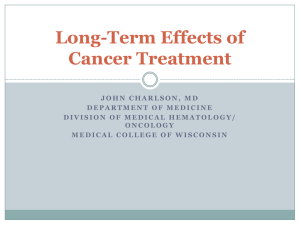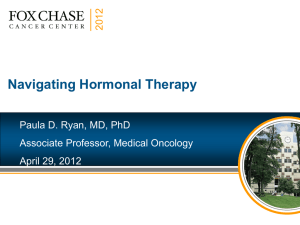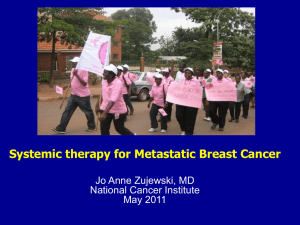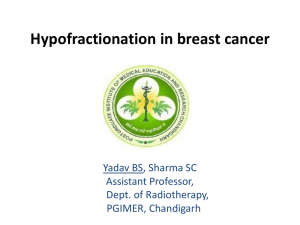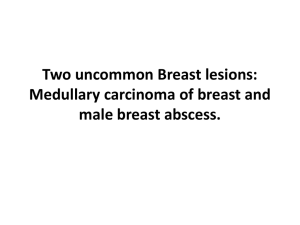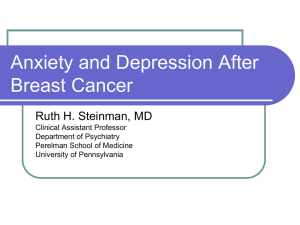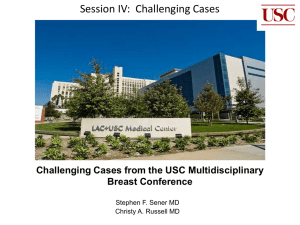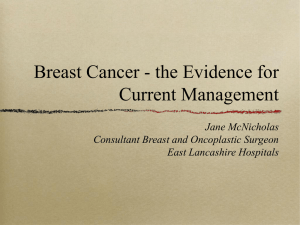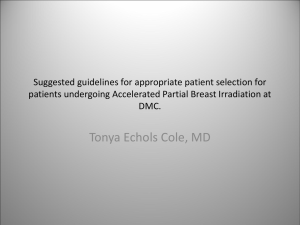09.Systemic Therapy for Early Stage Disease
advertisement
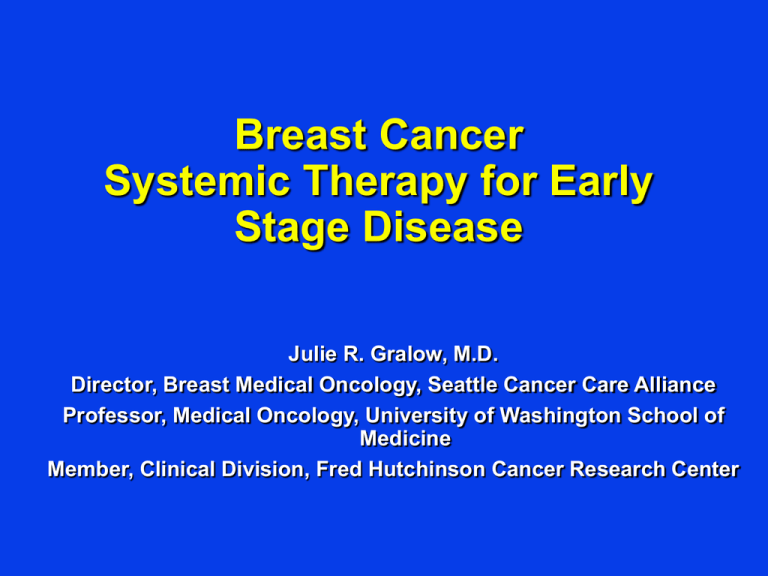
Breast Cancer Systemic Therapy for Early Stage Disease Julie R. Gralow, M.D. Director, Breast Medical Oncology, Seattle Cancer Care Alliance Professor, Medical Oncology, University of Washington School of Medicine Member, Clinical Division, Fred Hutchinson Cancer Research Center Adjuvant Systemic Treatment of Breast Cancer • Breast cancer is most often curable when detected in early stages • Micrometastases exist at the time of diagnosis in many patients, leading to eventual recurrence • Adjuvant systemic therapy has been found to prolong both overall and disease-free survival in breast cancer patients Systemic Therapy for Breast Cancer Endocrine Therapy Chemotherapy Biologically-targeted Therapy New Strategies: Individualizing treatment to the cancer and the patient Systemic Treatment of Early Stage Breast Cancer • THE PAST (2000 NCI Consensus Development Conference on Adjuvant Breast Cancer) – Chemotherapy should be offered to the majority of women with early stage breast cancer regardless of size, lymph node, menopausal or hormone receptor status • THE PRESENT AND FUTURE – Individualizing estimates of recurrence risk and chemotherapy benefit using genomic/molecular profiling – Many patients don’t need chemotherapy The Genomic Era Understanding the Genetic Changes in Each Individual Tumor normal cell atypical cell Genetic change cancer cell Genetic change Testing the acquired genetic makeup of the tumor can lead to more effective treatment strategies Genomics of Breast Cancer: Breast Cancer is NOT One Disease! Luminal Luminal HER-2+Basal Normal Subtypes vary with Subtype A Subtype B Subtype Breast–like respect to: • Likelihood of recurrence • Sites of metastases • Response to treatment Sorlie et al, Proc Natl Acad Sci 100:8418, 2003 Clinically Available Molecular Profiling Assays in Breast Cancer Genomic Health Oncotype Dx 21-Gene Recurrence Score Assay Agendia Mammaprint 70-Gene Prognostic Signature Assay Who Doesn’t Need Chemotherapy? Oncotype Dx 21-Gene Recurrence Score Assay Developed to help define which “low risk” patients do not need chemotherapy, and which may benefit Fixed (stored) tissue Surgical removal of tissue Recurrence score results Extract tumor RNA Tumor evaluated for 21 genes •In lymph node negative, ER+ breast cancer: •20% recurrence with tamoxifen only (may benefit from chemo) •80% won’t recur with tamoxifen only (won’t benefit from chemo) 21 Gene Recurrence Score (RS) Assay: 16 Cancer Genes and 5 Reference Genes PROLIFERATION Ki-67 STK15 Survivin Cyclin B1 MYBL2 INVASION Stromolysin 3 Cathepsin L2 ESTROGEN ER PR Bcl2 SCUBE2 GSTM1 CD68 BAG1 HER2 GRB7 HER2 REFERENCE Beta-actin GAPDH RPLPO GUS TFRC 21-Gene Recurrence Score Assay Results (Oncotype DX) Recurrence Score in LN-, ER+ if 5 Years Tamoxifen RS of 39 = 27% 10 yr distant relapse rate despite tamoxifen Lower RS Higher RS • Greater likelihood of recurrence • Less likelihood of recurrence • Less tamoxifen benefit • Greater tamoxifen benefit • Clear chemotherapy benefit • No to minimal chemotherapy benefit Endocrine Therapy Estrogen and Breast Cancer Aromatase inhibitors, ovarian suppression Estrogen SERMS, SERDS Estrogen Receptor Cell Growth and Division Endocrine Therapy in Breast Cancer • Selective Estrogen Receptor Modulators – tamoxifen – toremifene – raloxifene • Aromatase inhibitors (postmenopausal) – anastrozole – letrozole – exemestane • Medical or surgical oophorectomy (premenopausal) • Selective Estrogen Receptor Downregulators – fulvestrant • Others: Progestins, Estrogens, Androgens Selective Estrogen Receptor Modulators Early Breast Cancer Trialists’ Collaborative Group 2000 (Oxford Overview) Tamoxifen vs. Nil: Disease-free Survival ER Negative ER Positive tamoxifen nil ER status matters!! 5 years of adjuvant tamoxifen became standard in ER+ patients Aromatase Inhibitors Anastrozole Letrozole Exemestane Cortisol Adrenal Hormones Androstenedione Estrone Aromatase inhibitors block post-menopausal estrogen production Aldosterone Testosterone Estradiol Adjuvant Aromatase Inhibitors Three Strategies AIs as Initial Therapy AIs After 2-3 Yrs of TAM TAM X 5 Yrs TAM X 5 Yrs AIs After 5 Years of TAM AI X 5 Yrs TAM X 5 Yrs AI X 5 Yrs TAM X 2-3 AI X 2-3 ATAC and BIG1-98 studies Reduction in recurrences Survival benefit for AI arm PLAC X 5 Yrs Upfront Use of Aromatase Inhibitors vs. Tamoxifen ATAC Trial: Anastrozole vs. Tamoxifen Howell A et al, Lancet 365:60-62, 2005 68 months follow-up: 17% relative reduction in events for A vs T (3% absolute difference) No difference in overall survival BIG 1-98 Trial: Letrozole vs. Tamoxifen Thurlimann B et al, NEJM 353: 2747-57, 2005 26 months follow-up: 19% relative reduction in events for L vs. T (3% absolute difference) No difference in overall survival Extended Adjuvant Hormonal Therapy Trials MA17 Trial: Letrozole vs. Placebo After Completing 5 Years of Tamoxifen Goss P et al, J Natl Cancer Inst 97: 1262-71, 2005 30 months of follow-up: 42% decrease in breast cancer events Node positive patients show statistically significant improvement in survival Ovarian Ablation in Early Stage Breast Cancer Early Breast Cancer Trialists’ Collaborative Group 2000 (Oxford Overview) Overall Survival Ablation vs. Not ablation No ablation Chemo/Ablation vs. Chemo Chemotherapy EBCTCG (Oxford Overview) 2000 Chemotherapy vs. Not: Deaths (Overall 14.8% +/- 2.1 reduction) Entry Age Events/Women Ratio annual deaths Chemo Control Chemo: Control 29%+/-7 < 40 293/960 335/908 40-49 50-59 (30.5%) (36.9%) 674/2480 783/2391 (27.2%) (32.7%) 1658/4880 (34.0%) 60-69 70+ 1918/5143 2000/4967 (37.9%%) (40.3%) (36.8%) 15%+/-3 (37.3%) 1851/4886 210/570 26%+/-5 7%+/-4 264/610 11%+/-11 (43.3%) 0.5 1.0 1.5 Survival Relative to Delivered Dose Adjuvant CMF Therapy - 20 Year Follow-up Milan Study (N = 386) Bonadonna G et al, N Engl J Med 1995 Overall survival 1.0 Control 1.0 0.9 <65% of dose 0.9 0.8 65-84% of dose 0.8 85% of dose 0.7 0.6 0.5 0.4 0.3 0.2 0.1 Probability of Overall Survival Probability of Relapse-free Survival Disease-free survival 0.7 0.6 0.5 0.4 0.3 0.2 0.1 0.0 0.0 5 10 15 Years after Mastectomy 20 5 10 15 Years after Mastectomy 20 Anthracyclines vs. CMF EBCTCG (Oxford Overview) 2006 Meta-Analysis Presented ASCO Educational Session 2007 • Many studies with relatively low doses of anthracyclines included in analysis • Magnitude of benefit probably underestimated Adjuvant Taxanes CALGB 9344: AC +/- Paclitaxel in LN+ Breast Cancer Henderson IC et al, J Clin Oncol 2003 A 60 vs 75 vs 90 mg/m2 + C 600 mg/m2 q3 wks x 4 DFS (5 yrs) OS AC 65% 77% T 175 mg/m2 q3 wks x 4 n=3,121 No T AC + T 70% HR = 0.83, p=0.0023 80% HR = 0.82, p=0.0064 BCIRG 001: TAC vs FAC in Breast Cancer Martin M, et al, N Engl J Med 2005 F 500 mg/m2 vs A 50 mg/m2 C 500 mg/m2 q3 wks x 6 DFS (55 months) OS TAC 75% 87% T (Docetaxel) 75 mg/m2 A 50 mg/m2 C 500 mg/m2 q3 wks x 6 FAC 68% 81% n=1,491 HR = 0.72, p=0.001 HR = 0.7, p=0.008 Biologic Therapy HER-2 as a Target for Therapy HER-2 Oncogene: amplified and overexpressed in 20-25% of breast cancer HER-2 Trastuzumab (Herceptin) Anti-HER-2 Antibody cancer cell nucleus Lapatinib (Tykerb) Dual HER-1/HER-2 Tyrosine Kinase Inhibitor cell division 26 Adjuvant Chemotherapy +/Trastuzumab: NSABP B-31 and N9831 Romond E et al, N Engl J Med 353, 2005 300 250 Number of patients 200 Chemo Alone 150 Chemo + Trastuzumab 100 50 0 Recurrence Death •Risk of breast cancer recurrence reduced by 52% at 3 yrs •Risk of death decreased by 33% at 2 yrs Adjuvant Therapy in Breast Cancer: The Future • Clinical features, stage and biology all contribute to risk of recurrence! • Endocrine therapy critical in ER+ breast cancer • In chemotherapy-sensitive breast cancers, anthracycline and taxanes both add to disease control • Many patients don’t need chemo! • Trastuzumab significantly reduces breast cancer recurrence and death in HER2+ • Ongoing prospective trials are integrating traditional and novel markers of risk to better define tailored options for early-stage breast cancer

